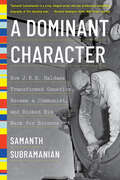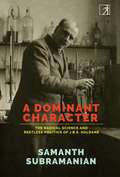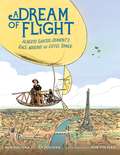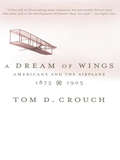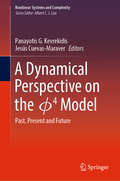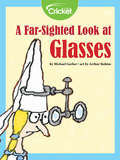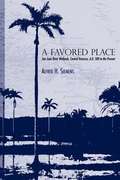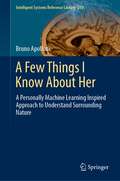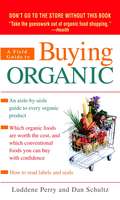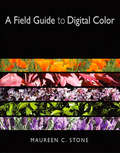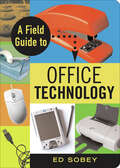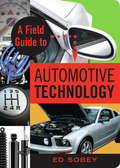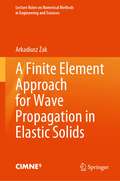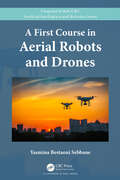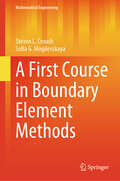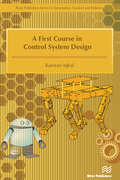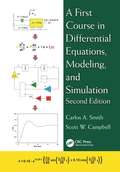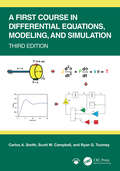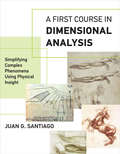- Table View
- List View
A Ditadura Militar e a Governança da Água no Brasil: Ideologia, Poderes Político-Econômico e Sociedade Civil na Construção das Hidrelétricas de Grande Porte (The Role of Ideology, Political-Economic Power and Civil Society in the Construction of Large Hydropower Dams) (IHE Delft PhD Thesis Series)
by Fernanda de Souza BragaIn recent decades there has been an exponential increase in large hydroelectric plants in Brazil, especially in the Amazon region. These large hydraulic structures impact the environment and the lives of people living in the places where they settle and require a special type of water governance. The dictatorial regime (1964-1985) created a "standard" for the construction of these great structures, through an institutional and legal framework, which benefited the Brazilian business elite but also, through the creation of a popular imagination, which shows itself lasting progress on the country's progress and development. The suspension of security, the fragility of institutional environmental structures, the disrespect for indigenous reserves, the lack of clarity about the concept of "affected population" and the non-payment of fair compensation were identified as one of the main challenges for a democratic water governance in the country. In the late 1970s, the Dam-Affected Movement (MAB) began its organization and is also studied in this research. The study is an important and insightful academic contribution to the understanding of the main bottlenecks of effective water governance in Brazil.
A Diversity of Pathways Through Science Education
by Yew-Jin Lee Yann Shiou Ong Timothy Ter Ming TanThis book presents the work of academics who contributed their work at the International Science Education Conference (ISEC) 2021, in alignment with the conference theme '20/20 Vision for Science Education Research.' Collectively, the chapters aim to evoke intellectual dialogues on current and future trends in science education. It features chapters that are grouped thematically into three sections: Questions and Questioning in Science/STEM education, Developing Science Teaching and Assessment, and History, Philosophy, and Sociology of Science/Engineering, and Informal Learning. Through the various sections, the book presents empirical studies in science and engineering classrooms or laboratories, puts forward a framework for problem-based learning, provides an account of a prominent scientist’s efforts in promoting practical science through analysis of historical documents, and uncovers trends in informal science learning space research through a review of literature. Each section is introduced by a commentary with further insights and thought-provoking questions on ideas raised in the chapters. The book also includes a 'Notes to Our Future Colleagues' section in each chapter, which presents readers with a collective vision for the state of science education research in the year 2050.
A Dog for All Seasons: A Memoir
by Patti Sherlock“A moving memoir of a loving relationship with a dog and the trials and tribulations of living on a western sheep farm.” —Temple Grandin, New York Times–bestselling authorPatti Sherlock's working relationship with her Border Collie, Duncan, got her through the ups and downs of sixteen years on a sheep farm in Idaho. During that time, Duncan was an unwavering companion through the destruction of Patti's marriage, her children inevitably leaving home one by one, and eventually, her decision to stop raising sheep. Patti's life on the farm is a reflection of beginnings and endings, and the cycle of seasons in all of our lives.“If you've forgotten how to see miracles in everyday moments, this book will remind you. It's a story about the real world, the world where human beings live in constant contact with nature, and where animals are more than best friends.” —W. Michael Gear and Kathleen O'Neal Gear, New York Times–bestselling authors“A Dog for All Seasons gives us the convergence of a remarkable woman, a wonderful dog, and a fascinating way of life. It's the literary equivalent of fresh air, pure water, and sparkling sunlight. The book should be savored.” —Tim Sandlin, author of Skipped Parts“Tender, wise, and deeply affecting, Sherlock's vignettes will make readers smile and sigh and wish for their own Duncan.” —Publishers Weekly
A Dominant Character: The Radical Science And Restless Politics Of J. B. S. Haldane
by Samanth SubramanianA biography of J. B. S. Haldane, the brilliant and eccentric British scientist whose innovative predictions inspired Aldous Huxley’s Brave New World. J. B. S. Haldane’s life was rich and strange, never short on genius or drama—from his boyhood apprenticeship to his scientist father, who first instilled in him a devotion to the scientific method; to his time in the trenches during the First World War, where he wrote his first scientific paper; to his numerous experiments on himself, including inhaling dangerous levels of carbon dioxide and drinking hydrochloric acid; to his clandestine research for the British Admiralty during the Second World War. He is best remembered as a geneticist who revolutionized our understanding of evolution, but his peers hailed him as a polymath. One student called him “the last man who might know all there was to be known.” He foresaw in vitro fertilization, peak oil, and the hydrogen fuel cell, and his contributions ranged over physiology, genetics, evolutionary biology, mathematics, and biostatistics. He was also a staunch Communist, which led him to Spain during the Civil War and sparked suspicions that he was spying for the Soviets. He wrote copiously on science and politics in newspapers and magazines, and he gave speeches in town halls and on the radio—all of which made him, in his day, as famous in Britain as Einstein. It is the duty of scientists to think politically, Haldane believed, and he sought not simply to tell his readers what to think but to show them how to think. Beautifully written and richly detailed, Samanth Subramanian’s A Dominant Character recounts Haldane’s boisterous life and examines the questions he raised about the intersections of genetics and politics—questions that resonate even more urgently today.
A Dominant Character: The Science and Politics of J.B.S. Haldane
by Samanth SubramanianJ.B.S. Haldane, scientist extraordinaire—born in Britain yet spiritually bound to India—remains one of the most enigmatic geniuses of the modern era. Here is a man who saw action in two world wars, engaged in the most radical politics of his day, conducted groundbreaking scientific research, and wrote with flair and conviction—yet Haldane&’s universe remains shrouded in mystery. <P><P>Award-winning author Samanth Subramanian’s latest offering undoes this travesty. Besides shedding light on Haldane’s contributions to genetics and evolutionary biology—he was the first to calculate the rate at which mutations occur and accumulate in genes—the book illuminates Haldane&’s inner world—his towering intellect, his radical vision of society, his provocative philosophy, and his attempts a wrestling with the essential moral questions that scientific progress must raise. <P><P>Equally, the book dwells on Haldane’s years in India—his journey to the nation; his affiliation with the Indian Statistical Institute, Calcutta; his attachment to the Genetics and Biometry Laboratory in Bhubaneshwar (where he died). Dronamraju’s description of Haldane as ‘the last man who knew everything’ was, at its simplest, an acknowledgement of his command over multiple subjects. But it was also an astute observation that Haldane’s era was the last time when the realms of scientific knowledge were limited enough for a single person to apprehend in near-entirety. To know everything was to see the forces of the world unified and to conceive of life in its full complexity. A Dominant Character will give readers a taste of that heady sensation.
A Dream of Flight: Alberto Santos-Dumont's Race Around the Eiffel Tower
by Rob Polivka Jef PolivkaDebut nonfiction duo Rob and Jef Polivka offer an illustrated madcap adventure in A Dream of Flight, a dynamic biography of Alberto Santos-Dumont, an inventor who risked everything to reach the skies. And sure enough, his successes and failures brought the world’s people closer together.Ready? Set. Fly! At the turn of the twentieth century, no aviation prize was more coveted in Europe than the Deutsch Prize. To win it, a pilot would have to fly a balloon from Paris’s Aero Club around the Eiffel Tower and back in thirty minutes or less. Who would be the first to succeed?Alberto Santos-Dumont thought he could. His latest design, Airship No. 6, was perfected from the countless lessons he learned during previous crashes. On the morning of October 19, 1901, Santos was making good time in the race when disaster struck—his motor had sputtered to a stop mid-air! Would Santos make it to the finish line in time—let alone survive?
A Dream of Wings: Americans and the Airplane, 1875-1905
by Tom D. CrouchThe story of a handful of talented American engineers and adventurers who labored to conquer gravity in a flying machine. When Orville and Wilbur Wright soared over Kill Devil Hills in North Carolina's outer banks and solved the problem of aerial navigation, they wrote the last chapter in a long story. For decades prior, a small community of engineers, scientists, and dreamers--men named Chanute and Langley and Herring--had tried to make the ascent in every conceivable craft, from kites and gliders to an assortment of powered flying models. This fascinating assortment of characters and contraptions comes to life in Tom Crouch's classic A Dream of Wings. In the quest for flight, aeronautical societies were formed and broke apart, successes were celebrated, hopes rose and fell, and lessons were learned and built upon. The dreamers who blazed the path to a flying machine are bravely realized in these delightful pages.
A Dynamical Perspective on the ɸ4 Model: Past, Present and Future (Nonlinear Systems and Complexity #26)
by Jesús Cuevas-Maraver Panayotis G. KevrekidisThis book presents a careful selection of the most important developments of the \phi^4 model, offering a judicious summary of this model with a view to future prospects and the challenges ahead. Over the past four decades, the \phi^4 model has been the basis for a broad array of developments in the physics and mathematics of nonlinear waves. From kinks to breathers, from continuum media to discrete lattices, from collisions of solitary waves to spectral properties, and from deterministic to stochastic models of \phi^4 (and \phi^6, \phi^8, \phi^12 variants more recently), this dynamical model has served as an excellent test bed for formulating and testing the ideas of nonlinear science and solitary waves.
A Far-Sighted Look at Glasses
by Michael GerberHave you ever wondered where glasses came from? This comic takes a fun look at the invention of glasses starting with the Greeks and Romans. Then it looks at attempts by the Spanish, Chinese, French, and even inventor Ben Franklin to improve the design.
A Farm Through Time
by Angela Wilkes Eric ThomasThis is the story of a farm and of its place in a changing landscape, from the Middle Ages to the present day. Following the rhythm of the seasons, it shows generations of farmworkers carrying out their daily tasks, ploughing and sowing, harvesting and haymaking. The book traces the development of the farm from a 9th century small-holding, rented from the local lord of the manor, to a large, mechanised farm of the 21st century. Eric Thomas' evocative illustrations capture the atmosphere of a rural idyll, showing farming communities working on the land, while liftable flaps open to reveal activities inside the farm buildings. Angles Wilkes' lyrical text explains traditional crafts and customs, from repairing hedges to making cheese. A Farm Through Time is a portrait of country people, of disappearing crafts and the emergence of new technology, and of how, over time, farming has altered the landscape itself.
A Favored Place: San Juan River Wetlands, Central Veracruz, A.D. 500 to the Present
by Alfred H. SiemensI doubt there is a wetland environment anywhere in the Americas inhabited, used, and modified as long as San Juan Basin, and by as many cultures with different technologies. This story needs to be told. --William E. Doolittle, Professor of Geography, University of Texas at Austin The wetlands of the San Juan Basin in Central Veracruz, Mexico, have been a favored place since the fifth century A. D. , when Prehispanic people built an extensive network of canals and raised fields that allowed for almost year-round agriculture. Alfred Siemens' discovery of the remains of this network in the 1970s led him to uncover fifteen centuries of land-use history in the region. This book contains a full record of his findings. Siemens organizes his history of the San Juan Basin around the question: What relationships exist between Prehispanic agriculture and the production systems of the tropical lowlands in our own time? This focus allows him to chart the changes in human perceptions and uses of the landscape, from the Prehispanic wetland agricultural system to the drained pastures of today's cattle ranches. Amplified with air oblique photography, maps, and tables, and enriched with data from archaeology and colonial archives, this is an authoritative historical geography of a wetland landscape. Or, in the author's more modest words, It seems to me that what I have here is a biography of a swamp.
A Few Things I Know About Her: A Personally Machine Learning Inspired Approach to Understand Surrounding Nature (Intelligent Systems Reference Library #219)
by Bruno ApolloniThis book reconsiders key issues, such as description and explanation, which affect data analytics. For starters: the soul does not exist. Once released from this cumbersome roommate, we are left with complex biological systems: namely, ourselves, who must configure their environment in terms of worlds that are compatible with what they sense. Far from supplying yet another cosmogony, the book provides the cultivated reader with computational tools for describing and understanding data arising from his surroundings, such as climate parameters or stock market trends, even the win/defeat story of his son football team. Besides the superposition of the very many universes considered by quantum mechanics, we aim to manage families of worlds that may have generated those data through the key feature of their compatibility. Starting from a sharp engineering of ourselves in term of pairs consisting of genome plus a neuron ensemble, we toss this feature in different cognitive frameworks within a span of exploitations ranging from probability distributions to the latest implementations of machine learning. From the perspective of human society as an ensemble of the above pairs, the book also provides scientific tools for analyzing the benefits and drawbacks of the modern paradigm of the world as a service.
A Field Guide to Buying Organic
by Luddene Perry Dan SchultzThe definitive guide to healthful, affordable food shopping in the Organic Age--from a pioneer in the organic movement. What does it really mean when a food is labeled organic? While many of us believe there are good reasons to buy organic, what exactly are they? The authors of this indispensable handbook sift fact from fiction to help you make informed decisions that are right for you. Here is everything you need to know, including when paying more for organic is worth it--and when it's not. A Field Guide to Buying Organic provides you with: ·Self-tests to determine your current organic-shopping habits--and the type of organic shopper you want to become ·A primer on organic food standards, labels, and seals ·Health and quality comparisons of organically grown versus conventionally grown produce ·An aisle-by-aisle supermarket guide to information about the most popular organic produce, dairy, meat and poultry, baked goods, nuts, seeds, grains, convenience foods, and drinks ·The truth about pesticides, hormones, genetically modified foods (GMOs), toxins, and bacteria ...Plus illustrations featuring product logos and contact information, and a fascinating overview of the evolution of organics From the Trade Paperback edition.
A Field Guide to Digital Color
by Maureen StoneMaureen Stone's field guide to digital color presents a survey of digital color with special emphasis on those fields important for computer graphics. The book provides the foundation for understanding color and its applications, discusses color media and color management and the use of color in computer graphics, including color design and selecti
A Field Guide to Household Technology
by Ed SobeyIllustrating how a fire alarm detects smoke and what the "plasma" is in a plasma screen television, this fascinating handbook explains how everyday household devices function and operate. More than 180 different household technologies are covered, including gadgets unique to apartment buildings and houseboats. Devices are grouped according to their "habitats"--the living room, family room, den, bedroom, kitchen, bathroom, and basement--and feature a detailed description of what the device does and how it works, as well as a photograph for easy identification. With helpful sidebars describing related technical issues, such as why a cheap dimmer switch can interfere with radio reception, this handbook for curious readers provides carefully detailed descriptions and the history behind many of the older household technologies like toasters and faucets to newer technologies like motion detectors, TiVo, and satellite radio.
A Field Guide to Office Technology
by Ed SobeyWith more than 160 entries detailing everything from the junk buried in desk drawers to that mysterious box blinking away in the coat closet, this practical guide navigates through modern office technology. Each entry includes a functional description of a device (what it is and how it works) as well as particulars on who invented it and how its design has evolved over the years. Devices are grouped according to their habitats--in the conference room, hanging from the ceiling, or connected to a computer--to assist in quick and easy identification. Solving office mysteries, such as why telephone keypads have their ones in the upper left corner while calculator keypads place the ones in the lower left corner, this fascinating resource decodes the often confusing technological landscapes of everyday offices.
A Field Guide to utomotive Technology
by Ed SobeyWritten for mechanical novices who may not know their catalytic converters from their universal joints, this practical guide helps teach a basic understanding of how automobiles function. Devices are grouped according to their habitats--under the hood, inside the car, and more--to help identify the technology in question. Solving automotive puzzles such as where exactly does a dipstick dip and what is rack and pinion steering, this handy reference illuminates what's going on under the hood without all that grime and grease.
A Finite Element Approach for Wave Propagation in Elastic Solids (Lecture Notes on Numerical Methods in Engineering and Sciences)
by Arkadiusz ŻakThis book focuses on wave propagation phenomena in elastic solids modelled by the use of the finite element method. Although the latter is a well-established and popular numerical tool used by engineers and researchers all around the word the process of modelling of wave propagation can still be a challenge. The book introduces a reader to the problem by presenting a historical background and offering a broad perspective on the development of modern science and numerical methods. The principles of wave phenomena are clearly presented to the reader as well as the necessary background for understanding the finite element method, which is the following chapter of the book is viewed from the modeller point-of-view. Apart from the principles the book also addresses more advanced topics and problems including the use of the spectral-finite element method, the spline-based finite element method as well as the problems of undesired and hidden properties of discrete numerical models.
A First Course in Aerial Robots and Drones (Chapman & Hall/CRC Artificial Intelligence and Robotics Series)
by Yasmina Bestaoui SebbaneA First Course in Aerial Robots and Drones provides an accessible and student friendly introduction to aerial robots and drones. Drones figure prominently as opportunities for students to learn various aspects of aerospace engineering and design. Drones offer an enticing entry point for STEM studies. As the use of drones in STEM studies grows, there is an emerging generation of drone pilots who are not just good at flying, but experts in specific niches, such as mapping or thermography. Key Features: Focuses on algorithms that are currently used to solve diverse problems. Enables students to solve problems and improve their science skills. Introduces difficult concepts with simple, accessible examples. Suitable for undergraduate students, this textbook provides students and other readers with methods for solving problems and improving their science skills.
A First Course in Boundary Element Methods (Mathematical Engineering)
by Steven L. Crouch Sofia G. MogilevskayaThis textbook delves into the theory and practical application of boundary integral equation techniques, focusing on their numerical solution for boundary value problems within potential theory and linear elasticity. Drawing parallels between single and double layer potentials in potential theory and their counterparts in elasticity, the book introduces various numerical procedures, namely boundary element methods, where unknown quantities reside on the boundaries of the region of interest. Through the approximation of boundary value problems into systems of algebraic equations, solvable by standard numerical methods, the text elucidates both indirect and direct approaches. While indirect methods involve single or double layer potentials separately, yielding physically ambiguous results, direct methods combine potentials using Green’s or Somigliana’s formulas, providing physically meaningful solutions. Tailored for beginning graduate students, this self-contained textbook offers detailed analytical and numerical derivations for isotropic and anisotropic materials, prioritizing simplicity in presentation while progressively advancing towards more intricate mathematical concepts, particularly focusing on two-dimensional problems within potential theory and linear elasticity.
A First Course in Control System Design
by Kamran IqbalControl systems are pervasive in our lives. Our homes have environmental controls. The appliances we use at home, such as the washing machine, microwave, etc. have embedded controllers. We fly in airplanes and drive automobiles, which make extensive use of control systems. The increasing automation in the past few decades has increased our reliance on control systems.A First Course in Control System Design discusses control systems design from a model-based perspective as applicable to single-input single-output systems. The emphasis in this book is on understanding and applying the techniques that enable the design of effective control systems. The book covers the time-domain and the frequency-domain design methods, as well as the design of continuous-time and discrete-time systems.Technical topics discussed in the book include: Modeling of physical systems Analysis of transfer function and state variable models Control system design via root locus Control system design in the state-space Control design of sampled-data systems Compensator design via frequency response modification
A First Course in Control System Design
by Kamran IqbalControl systems are pervasive in our lives. Our homes have environmental controls. The appliances we use, such as the washing machine, microwave, etc. carry embedded controllers in them. We fly in airplanes and drive automobiles that extensively use control systems. The industrial plants that produce consumer goods run on process control systems. The recent drive toward automation has increased our reliance on control systems technology.This book discusses control systems design from a model-based perspective for dynamic system models of single-input single-output type. The emphasis in this book is on understanding and applying the techniques that enable the design of effective control systems in multiple engineering disciplines. The book covers both time-domain and the frequency-domain design methods, as well as controller design for both continuous-time and discrete-time systems. MATLAB© and its Control Systems Toolbox are extensively used for design.
A First Course in Differential Equations, Modeling, and Simulation
by Carlos A. Smith Scott W. CampbellA First Course in Differential Equations, Modeling, and Simulation shows how differential equations arise from applying basic physical principles and experimental observations to engineering systems. Avoiding overly theoretical explanations, the textbook also discusses classical and Laplace transform methods for obtaining the analytical solution of
A First Course in Differential Equations, Modeling, and Simulation
by Carlos A. Smith Scott W. Campbell Ryan G. ToomeyA First Course in Differential Equations, Modeling, and Simulation shows how differential equations arise from applying basic physical principles and experimental observations to engineering systems. Avoiding overly theoretical explanations, the textbook also discusses classical and Laplace transform methods for obtaining the analytical solution of differential equations. In addition, the authors explain how to solve sets of differential equations where analytical solutions cannot easily be obtained. Incorporating valuable suggestions from mathematicians and mathematics professors, the third edition: Reworks the chapter “Response of First and Second Order Systems” to include the system response to step changes, impulses, rectangular pulses, and sinusoid forcing functions as well as the response of coupled first- and second-order ordinary differential equations (ODEs); it also introduces Bode plots to analyze the frequency response of second-order ODEs and the principle of oscillation modes in coupled second-order ODEs Adds a new section on springs and dampers in series or parallel Includes new content on Simulink® and modeling Contains new exercises that can be used as projects and answers to many of the end-ofchapter problems Features new end-of-chapter problems and updates throughout This textbook provides students with a practical understanding of how to apply differential equations in modern engineering and science.A solutions manual and files of all figures in the text are available to adopting professors.
A First Course in Dimensional Analysis: Simplifying Complex Phenomena Using Physical Insight (The\mit Press Ser.)
by Juan G. SantiagoAn introduction to dimensional analysis, a method of scientific analysis used to investigate and simplify complex physical phenomena, demonstrated through a series of engaging examples.This book offers an introduction to dimensional analysis, a powerful method of scientific analysis used to investigate and simplify complex physical phenomena. The method enables bold approximations and the generation of testable hypotheses. The book explains these analyses through a series of entertaining applications; students will learn to analyze, for example, the limits of world-record weight lifters, the distance an electric submarine can travel, how an upside-down pendulum is similar to a running velociraptor, and the number of Olympic rowers required to double boat speed.The book introduces the approach through easy-to-follow, step-by-step methods that show how to identify the essential variables describing a complex problem; explore the dimensions of the problem and recast it to reduce complexity; leverage physical insights and experimental observations to further reduce complexity; form testable scientific hypotheses; combine experiments and analysis to solve a problem; and collapse and present experimental measurements in a compact form. Each chapter ends with a summary and problems for students to solve. Taken together, the analyses and examples demonstrate the value of dimensional analysis and provide guidance on how to combine and enhance dimensional analysis with physical insights. The book can be used by undergraduate students in physics, engineering, chemistry, biology, sports science, and astronomy.



